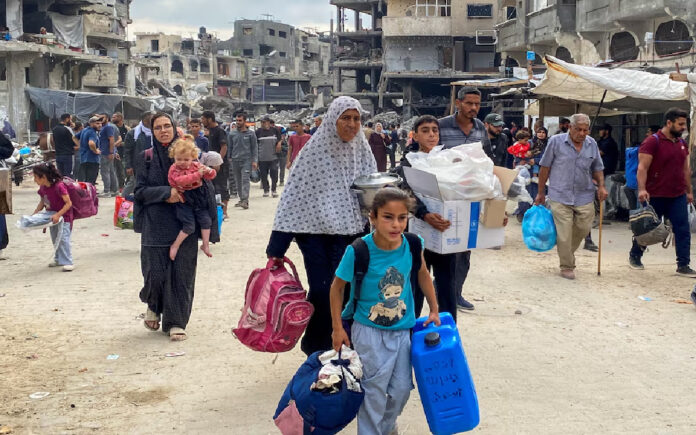Jerusalem: Israeli forces intensified their operations around Jabalia in northern Gaza on Monday, with reports of at least 10 people killed while queuing for food, according to Palestinian medics. Israel has instructed civilians to evacuate the area as its forces advance against Hamas fighters.
The Israeli offensive has concentrated on Jabalia for the past 10 days. Israeli military units have now encircled the refugee camp and sent tanks into nearby towns of Beit Lahiya and Beit Hanoun. The stated goal of these operations is to root out Hamas fighters attempting to regroup in the area.
Civilians in Jabalia, one of eight historic refugee camps in Gaza, face a difficult choice between Israel’s demands to move south and Hamas’s warnings against evacuation due to the risks involved.
“We have been hit from the air and the ground non-stop for a week. They want us to leave; they want to punish us for refusing to leave our homes,” said 26-year-old Marwa, who fled with her family to a school in Gaza City. Many fear that heading south would mean they may never return to their homes.
The United Nations human rights office expressed concern over Israel’s military strategy, stating that the Israeli forces appear to be “cutting off North Gaza completely from the rest of the Gaza Strip.” In its statement, the UN also raised alarm over the potential forced displacement of civilians, which could constitute a violation of international law.
Israeli officials, however, maintained that the evacuation orders were intended to separate Hamas fighters from civilians and denied any systematic plan to force civilians out of Jabalia or other northern areas. The Israeli military stated, “The IDF directs its strikes and operations only against terror targets and operatives and does not target civilian objects and civilians.”
As fighting continues, life for Gaza’s civilians has become unbearable. On Monday, 10 people were killed and 40 injured by tank shelling, including women and children, according to Palestinian medics. The Israeli military reported that the incident is under review.
Humanitarian conditions in Jabalia have worsened, with more than 50,000 people displaced and essential infrastructure, including water wells, bakeries, medical points, and shelters, being shut down. The northern region, home to more than half of Gaza’s 2.3 million residents, was heavily bombed in the early stages of the Israeli assault, prompting hundreds of thousands to evacuate. However, about 400,000 people remain, according to UN estimates.
Hamas accused Israel of attempting to displace northern Gaza’s population by force. “The international community should act against this war crime,” said senior Hamas official Sami Abu Zuhri.
Also Read | One Year of Gaza War | War Brews Where Chaos Reigns, and Peace Thrives Where Humanity Prevails
Proposal by Former Generals Stokes Fears of Forced Displacement
Concerns over the potential for large-scale displacement have been heightened by a proposal from former Israeli generals. The plan calls for northern Gaza to be cleared of civilians and remaining militants placed under siege until they surrender. The Israeli military denied that such a plan was in place.
“We have not received a plan like that,” said Israeli military spokesman Nadav Shoshani. “We are making sure we’re getting civilians out of harm’s way while we operate against terror cells in Jabalia.”
Also Read | Meta’s Facebook and Instagram Back Online for Most U.S. Users After Disruption
The proposal’s lead author, Giora Eiland, stated that his plan aimed to pressure Hamas into releasing hostages by stripping it of territorial control, rather than escalating military confrontation. “What they’re doing in Jabalia now is more of the same,” Eiland told Army Radio. “My plan is not being implemented.”
Israel’s future strategy for Gaza remains uncertain, beyond its declared objective of dismantling Hamas as both a military and governing force, and securing the release of hostages. Israel launched its offensive after Hamas’s October 7 attack, which resulted in the deaths of 1,200 people and the capture of around 250 hostages, according to Israeli reports. Gaza’s health authorities have reported more than 42,000 Palestinian deaths since the conflict began.



